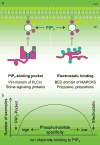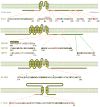PIP2 is a necessary cofactor for ion channel function: how and why?
- PMID: 18573078
- PMCID: PMC2692585
- DOI: 10.1146/annurev.biophys.37.032807.125859
PIP2 is a necessary cofactor for ion channel function: how and why?
Abstract
Phosphatidylinositol 4,5-bisphosphate (PIP2) is a minority phospholipid of the inner leaflet of plasma membranes. Many plasma membrane ion channels and ion transporters require PIP2 to function and can be turned off by signaling pathways that deplete PIP2. This review discusses the dependence of ion channels on phosphoinositides and considers possible mechanisms by which PIP2 and analogues regulate ion channel activity.
Figures





References
-
- Baukrowitz T, Schulte U, Oliver D, Herlitze S, Krauter T, et al. PIP2 and PIP as determinants for ATP inhibition of KATP channels. Science. 1998;282:1141–4. - PubMed
-
- Bian J, Cui J, McDonald TV. HERG K+ channel activity is regulated by changes in phosphatidylinositol 4,5-bisphosphate. Circ Res. 2001;89:1168–76. - PubMed
-
- Bian JS, Kagan A, McDonald TV. Molecular analysis of PIP2 regulation of HERG and IKr. Am J Physiol Heart Circ Physiol. 2004;287:H2154–63. - PubMed
-
- Branstrom R, Leibiger IB, Leibiger B, Corkey BE, Berggren PO, et al. Long chain coenzyme A esters activate the pore-forming subunit (Kir6.2) of the ATP-regulated potassium channel. J Biol Chem. 1998;273:31395–400. - PubMed
Publication types
MeSH terms
Substances
Grants and funding
LinkOut - more resources
Full Text Sources

